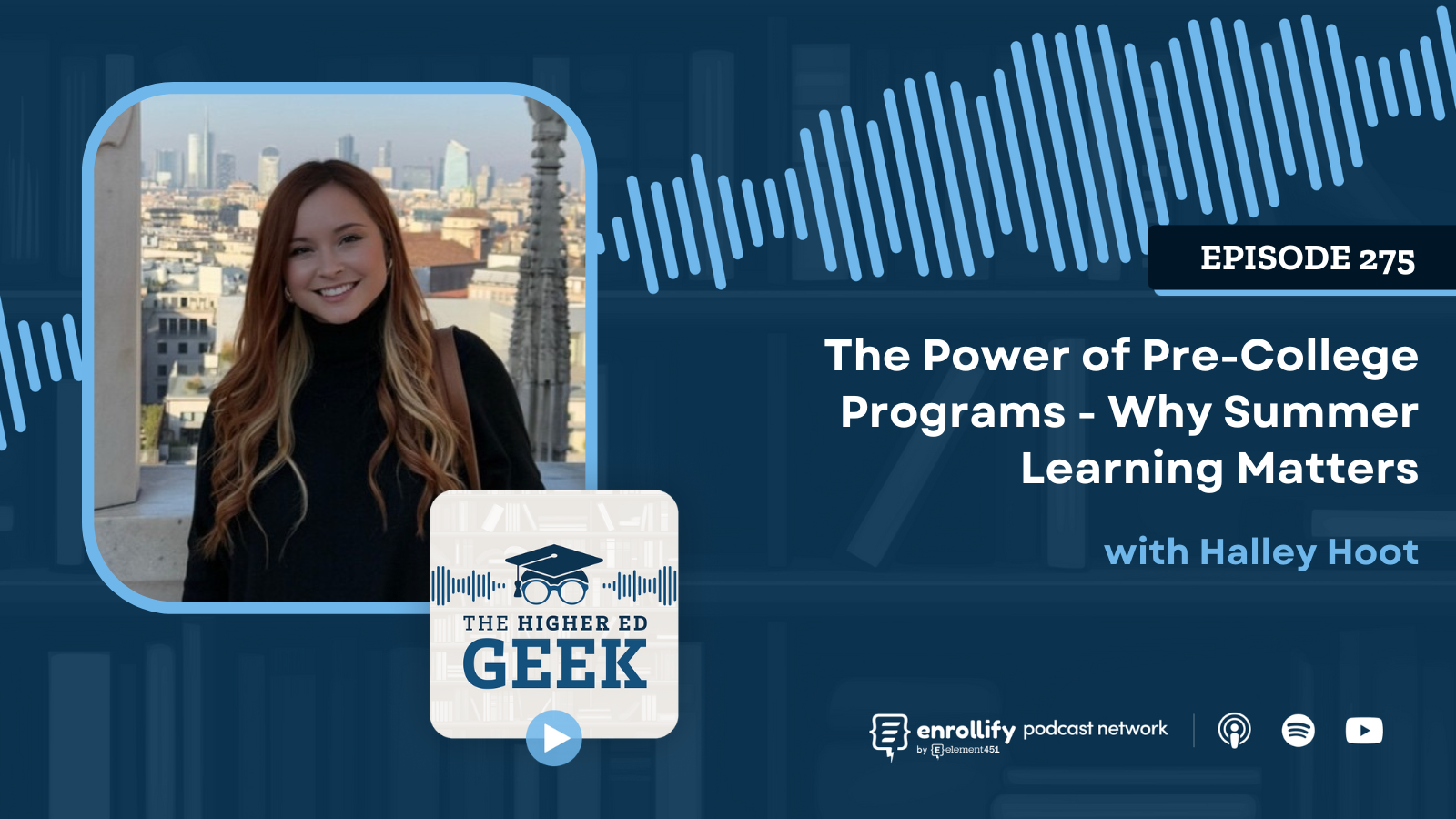About the Episode
In this episode, Jaime and her guest, Michael Lamphier, Executive Director for Marketing and Communication for Wake Forest School of Business, take a dive deep into the world of User Experience (UX) and its pivotal role in higher education marketing. Takeaways from this episode include:
- Inspiring success stories about tweaks in user experience that changed the trajectory of a marketing campaign
- Insights into the common hiccups institutions face when making UX a priority in their marketing strategies
- Tips for tools and strategies that are indispensable when gauging and boosting the user experience
- Ideas around staying on top of the rapid evolution of technology and student expectations, find out strategies to stay updated with the freshest trends and best practices in user experience.
Episode Summary
How Did Michael Lamphere’s Diverse Career Shape His Approach to Higher Ed Marketing?
Michael’s career spans consumer goods, media, and even billboard advertising, all of which contributed to his unique perspective on higher education marketing. His experience with big brands and direct-to-consumer marketing has equipped him with a data-driven, user-centered approach. Transitioning from the private sector, Michael emphasizes the need to be more student-focused in higher ed—building on core principles of user experience, especially as institutions face declining enrollments.
What Role Does User Experience Play in Higher Ed Marketing?
User experience (UX) goes beyond just website design; it's about the complete journey students have with an institution’s brand. Michael notes that in higher ed, UX includes everything from the ease of navigating a school’s website to the responsiveness of its admissions team. Streamlining these touchpoints helps students feel supported and valued, ultimately leading to higher enrollment numbers. Through real-world examples, Michael highlights how engaging digital tools like chatbots can streamline application processes, provide personalized responses, and reduce common friction points.
How Can Chatbots Like Drift’s Deke Bot Enhance User Experience?
Chatbots, especially AI-driven ones like Drift’s Deke Bot, are powerful tools for removing informational barriers and facilitating real-time engagement. For example, at Wake Forest, Deke Bot helped prospective students by automating consult bookings and reducing back-and-forth email communications. This efficiency doesn’t just save time for students; it also frees up admissions teams to focus on strategic interactions. Michael’s experience shows that students who interact through a chatbot have a 65% higher chance of starting an application—a metric that underscores the importance of integrating user-friendly technology into recruitment strategies.
How Should Higher Ed Marketers Approach UX Improvements?
Michael emphasizes that UX is an ongoing process of incremental improvement, not a one-time overhaul. Schools should adopt an iterative approach, frequently using data and student feedback to adjust and refine their processes. By employing tools like Hotjar for website analytics and BugHerd for real-time feedback, institutions can make immediate changes that improve user experience and remove friction. Instead of aiming for perfection, focusing on small, consistent improvements can lead to a significantly better user journey over time.
What Challenges Do Higher Ed Institutions Face in Enhancing UX?
One of the biggest obstacles in higher ed is resource constraints, particularly when it comes to web and design staff. Michael advises institutions to foster strong partnerships with in-house web developers and designers or, where possible, outsource certain tasks. Another challenge is overcoming the mindset in academia that marketing is less critical than academics. As he points out, higher ed institutions must embrace a sales-oriented approach if they are to survive in today’s competitive landscape, especially with enrollment challenges looming.
What Practical Steps Can Higher Ed Marketers Take to Enhance UX?
- Focus on Core Needs: Create essential one-stop information sheets with program details, costs, and requirements to make key information accessible.
- Employ UX Tools: Tools like Hotjar help analyze page engagement, and BugHerd allows teams to collaboratively manage website feedback, enhancing the overall user experience.
- Encourage Student Feedback: Holding focus groups or casual feedback sessions with current students can provide invaluable insights into what’s working and what isn’t.
This episode is brought to you by our friends at Mindpower:
Confessions of a Higher Ed CMO is sponsored by our friends at Mindpower- a full-service marketing and branding firm celebrating nearly thirty years of needle-moving, thought-provoking, research-fueled creative and strategy. Mindpower is women-founded and owned, WBENC certified, nationally recognized, and serves the social sector – higher education, healthcare, non-profits, and more. The Mindpower team is made up of strategists, storytellers, and experience creators. From market research to brand campaigns to recruitment to fundraising, the agency exists to empower clients, amplify brands, and help institutions find a strategic way forward. Learn more about Mindpower here!
About the Enrollify podcast Network:
Confessions of a Higher Ed CMO is a part of the Enrollify Podcast Network. If you like this podcast, chances are you’ll like other Enrollify shows too!
Our podcast network is growing by the month and we’ve got a plethora of marketing, admissions, and higher ed technology shows that are jam packed with stories, ideas, and frameworks all designed to empower you to be a better higher ed professional. Our shows feature a selection of the industry’s best as your hosts. Learn from Mickey Baines, Zach Busekrus, Jeremy Tiers, Eddie Francis, Jaime Gleason and many more.
Learn more about The Enrollify Podcast Network at podcasts.enrollify.org. Our shows help higher ed marketers and admissions professionals find their next big idea — come and find yours!







-1.png)







